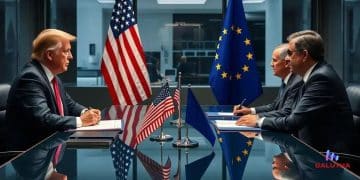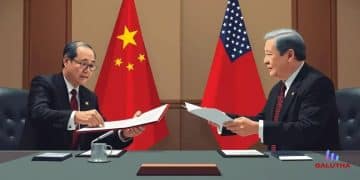Trump administration economic policies: What worked and what didn’t
The Trump administration’s economic policies focused on deregulation, tax reform, and job creation strategies, which aimed to stimulate growth but faced challenges from trade tensions and the COVID-19 pandemic.
The Trump administration economic policies brought significant changes that influenced various sectors. Have you ever wondered how these policies shaped today’s economy? Let’s dive into the specifics and uncover what really transpired.
Tax reforms and their effects
Key tax reforms during the Trump administration significantly impacted the U.S. economy. One of the most notable changes was the Tax Cuts and Jobs Act of 2017. This legislation aimed to stimulate growth by reducing the corporate tax rate from 35% to 21%.
Such a reduction offered businesses more money to invest in expansion and employee salaries. However, the effects were mixed as the benefits experienced by some sectors did not reach all Americans equally.
Immediate Effects on Businesses
Companies took advantage of lower tax rates, which led to increased investments. Many reported higher profits as a result. But how did these changes affect wages and job creation?
- Increased capital investments
- Rise in stock buybacks
- Some firms raised employee bonuses
- Mixed results in job growth
Despite the clear advantages for corporations, individual tax changes were also crucial. Many households received temporary tax cuts, which aimed to increase disposable income. This led to higher consumer spending in many areas, fostering economic growth.
However, many individuals faced expiration of these benefits after a few years. This uncertainty made long-term planning difficult for families.
Long-Term Consequences
In the long run, the tax reforms raised questions about sustainability. While immediate impacts were favorable, the resulting increase in the national deficit is a significant concern. Critics argue that the tax cuts primarily favor wealthy individuals and large corporations, widening the income gap.
Furthermore, these reforms established a precedent for future administrations. The debate over tax policy remains as economic conditions evolve. It’s essential to understand that while some benefited greatly from these changes, the promise of lasting economic improvement remains debatable.
The complexities of tax reforms highlight a broader discussion about economic fairness and growth.
Trade policies and their impact on markets

Trade policies during the Trump administration significantly shaped global markets. One of the most prominent actions was the imposition of tariffs on various goods, primarily targeting China. These tariffs aimed to protect American industries but also led to a series of economic responses.
Many businesses faced increased costs, forcing them to adjust prices. While some American companies thrived, others struggled to compete with foreign markets. This created a complex landscape where benefits were not always evenly distributed.
Impact on Agriculture
American farmers felt the effects of trade policies deeply. Tariffs on agricultural products led to tensions between the U.S. and other countries. For instance, when China imposed tariffs on soybeans, it affected many farmers’ incomes.
- Increased uncertainty in crop prices
- Dependence on government subsidies
- Shifts in export markets
- Long-term adjustments in farming strategies
Some sectors managed to adapt better than others. The technology industry, for example, faced unique challenges due to its reliance on global supply chains. Delays and increased costs became common, highlighting the fragility of interconnected markets.
As trade agreements were renegotiated, the focus shifted toward a more America-first mentality. This approach aimed at fostering domestic production while putting pressure on international trading partners. However, such policies have led to ongoing debates about their long-term effects on free trade and global cooperation.
Shifts in Consumer Behavior
Consumers also encountered changes due to trade policies. Prices for everyday goods fluctuated as tariffs increased the cost of imports. Many shoppers started paying closer attention to where products came from, leading to a rise in demand for locally-sourced items.
This trend reflects a broader awareness of global economics. People began to understand the real costs of trade wars and tariffs on their wallets. As such, the impact of trade policies extended beyond manufacturers and industries right into homes across the nation.
The dynamic nature of trade policies illustrates a balancing act between national interests and global economic relationships.
Regulatory changes and business growth
Regulatory changes during the Trump administration played a crucial role in shaping business growth. One of the primary focuses was deregulation, which aimed to reduce the burden on companies across various sectors. Lowering regulations often meant that businesses could operate more freely, with fewer compliance headaches.
This approach resonated well with many entrepreneurs looking to expand. As regulations were rolled back, companies found themselves with more resources available to invest in innovation and job creation. However, it also raised questions about the long-term impacts of reduced oversight.
Streamlined Processes
A significant aspect of regulatory changes involved streamlining processes that often delayed project approvals. Faster approvals meant that businesses could launch new products and services more quickly. This efficiency helped fuel growth in a competitive market.
- Faster environmental permits
- Simplified licensing procedures
- Reduction in compliance costs
- Encouragement for startups to enter the market
As companies expanded, they often hired more employees, leading to lower unemployment rates in several industries. The positive effects were evident as many businesses reported higher revenues. Yet, navigating the new regulatory landscape came with its challenges.
While the intent was to boost economic growth, some critics raised concerns about the potential risks involved. Lack of regulations in certain sectors can lead to negative externalities, such as environmental harm and unsafe working conditions. As businesses enjoyed newfound freedoms, they also faced a responsibility to consider these implications.
The Balance Between Growth and Oversight
Finding a balance between fostering growth and maintaining necessary regulations is a complex task. Data shows that while many companies flourished under the new rules, others felt pressured to prioritize profit over ethical considerations. Customer trust is invaluable, and companies have to weigh their decisions carefully.
In summary, the approach to regulations during the Trump administration highlighted the delicate interplay between encouraging business growth and safeguarding public interests.
Job creation strategies during the Trump era

Job creation strategies during the Trump era focused on promoting economic growth through a variety of initiatives. One key approach was the push for deregulation, which aimed to reduce the barriers for businesses to hire more workers. By easing regulations, companies had more freedom to expand and take risks.
Another significant strategy was tax reform, particularly the Tax Cuts and Jobs Act of 2017. This legislation not only lowered the corporate tax rate but also provided incentives for companies to invest in new hiring and capital expenditures. With more money in their pockets, many businesses started adding employees, leading to a boost in job creation.
Federal Infrastructure Investments
Investments in infrastructure were also a central strategy. The administration emphasized the need for rebuilding roads, bridges, and public transport systems, arguing that these projects would create millions of jobs.
- Initiating public-private partnerships
- Increasing funding for construction projects
- Targeting areas with high unemployment rates
- Encouraging local job creation through community projects
While some infrastructure projects did move forward, the scale and speed of implementation varied widely across states. These disparities meant that job growth was not uniform, with some regions benefiting more than others.
The emphasis on manufacturing jobs was also notable during this period. The administration aimed to bring back jobs that had moved overseas. By promoting American-made products and imposing tariffs on imports, the hope was to spurring domestic manufacturing.
Workforce Development Programs
In addition to these strategies, workforce development programs became a focus to ensure that workers had the necessary skills for available jobs. Partnerships with educational institutions were formed to create training programs aligned with the needs of modern businesses. These initiatives aimed to reduce the skills gap.
However, while many strategies showed promise, economic fluctuations and external factors also played significant roles in job creation. The ongoing conversations around trade policies and tariffs brought uncertainty for some industries, impacting hiring decisions.
Overall, the job creation strategies during the Trump era highlighted the complexities of the labor market in a rapidly changing economic landscape.
Economic challenges faced and lessons learned
The Trump administration faced several economic challenges that tested its strategies. One of the most significant issues was the volatility in global trade relations. Tariffs imposed on imports aimed to protect American industries but, consequently, sparked retaliatory measures from other countries. This resulted in increased prices for consumers and affected several sectors.
Additionally, the U.S. economy experienced fluctuations in growth rates during this period. While some quarters showed robust growth, others faced setbacks, leading to uncertainty among businesses and investors. Understanding these patterns became crucial for policymakers.
Impact of the COVID-19 Pandemic
The emergence of the COVID-19 pandemic in 2020 created unprecedented challenges. Lockdowns and restrictions led to significant job losses and business closures, disrupting the economic recovery that had been underway. Many industries struggled to adapt to rapid changes, highlighting the fragility of certain sectors.
- Mass layoffs in hospitality and travel
- Supply chain disruptions
- Shift to remote work for many industries
- Increased reliance on e-commerce
This crisis illustrated the importance of having adaptable strategies in place. Companies that invested in technology and flexible work arrangements often fared better than those that did not. Lessons learned during this period emphasized the need for resilience in business planning.
Regulatory Insights
Another lesson derived from these challenges was the importance of regulatory frameworks. While deregulation aimed to stimulate growth, the lack of oversight in critical areas became evident during financial strains. The need for a balance between encouraging growth and maintaining protections for workers and consumers became clearer.
Overall, economic challenges during the Trump administration offered valuable lessons on adaptability and foresight. Understanding the implications of trade policies, responding effectively to crises, and recognizing the balance needed in regulations all emerged as key themes to address in future policies.
FAQ – Economic Policies of the Trump Administration
What were the main economic strategies of the Trump administration?
The main strategies included deregulation, tax reforms, and initiatives to boost job creation and manufacturing.
How did the COVID-19 pandemic affect the economy during this period?
The pandemic caused significant job losses and business closures, disrupting economic recovery and testing existing strategies.
What lessons were learned from the economic challenges faced?
Key lessons included the importance of adaptability, balance in regulations, and the need to prepare for unforeseen crises.
What impact did trade policies have on businesses?
Trade policies led to increased costs for some businesses due to tariffs, while others benefited from protection against foreign competition.





